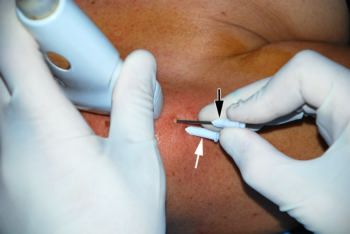Study Looks at Needles in Treatment for Shoulder Pain
No significant difference in clinical outcomes between single- and double-needle US-guided percutaneous irrigation of calcific tendinopathy

Researchers found no difference in using the single- or double-needle procedure when performing ultrasonography (US)-guided percutaneous irrigation of rotator cuff calcific tendinopathy, new Radiology research shows.
Davide Orlandi, MD, PhD, of Ospedale Evangelico Internazionale, Genoa, Italy, and colleagues analyzed the difference between the use of one or two needles in the percutaneous procedure that involves injecting saline solution into the tendon to dissolve the calcium deposits and then extracting the calcium-filled solution.
The study comprised 211 patients (77 men and 134 women between the ages of 24 and 69) who underwent US percutaneous irrigation between 2012 and 2014. The patients were randomly assigned to have the one-needle or the two-needle procedure.
Ultrasound exams were performed on each patient to identify the exact location of calcium deposits in the tendons and whether the deposit appeared to be hard or fluid. For patients in the double-needle procedure group, 16-gauge needles were inserted inside the calcification under continuous US monitoring, and the area was flushed with injections and extractions of saline until the tendon was free of visible calcium. The single-needle procedure utilized an 18-gauge needle for the injection and extraction.
Results showed no significant difference in short- and long-term clinical outcomes between single- and double-needle US-guided percutaneous irrigation of calcific tendinopathy.
“Procedure times were shorter and the calcium dissolution was easier when using two needles for hard calcifications and one needle for fluid calcifications,” said researcher Luca Maria Sconfienza, MD, PhD, associate professor at the University of Milan and chair of the Department of Radiology at the IRCCS Istituto Ortopedico Galeazzi. “In terms of clinical outcomes after one year of follow-up, there was no significant difference between single- and double-needle ultrasound-guided irrigation.”
At one-year follow-up, no residual or new calcifications or tendon tears at the site of the initial calcium deposits were detected.

Access the Radiology study, "Rotator Cuff Calcific Tendinopathy: Randomized Comparison of US-guided Percutaneous Treatments by Using One or Two Needles."